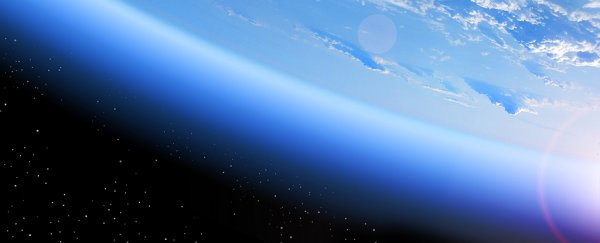Ozone-depleting substances are continuing to decrease more than three decades after a major international agreement phased out their production, according to a recently released UN-backed report.
We'll need to wait a few decades before raising the 'Mission Accomplished' banner. Knowing it'll take unprecedented levels of social change to combat global warming, the report even provides a glimmer of hope. Then again, it might be a glass half full kind of thing.
The United Nations' latest summary on the state of the ozone layer is a breath of fresh air for those thinking the environment is beyond repair, showing we're on track for the stratospheric column of ozone to return to 1980's levels by the second half of this century.
The Montreal Protocol on Substances that Deplete the Ozone Layer was set into force in 1989, setting a milestone in environmental protection by phasing out chemicals responsible for degrading the atmospheric layer of ozone.
Close to the ground, this oxygen-based molecule isn't all that welcome. But it does have a talent for absorbing the more harmful wavelengths of UV light that would otherwise get through to the surface.
At around 20 to 30 kilometres (12 to 19 miles) overhead, a rise in ozone density does a satisfactory job of soaking up a healthy proportion of that UV radiation without causing us grief.
In the 1980s researchers began to realise various chemicals employed in industrial and domestic processes – including the now infamous chlorofluorocarbons – were causing that ozone density to thin out.
While this degradation is a global phenomenon, observations of seasonal fluctuations over the Antarctic led to the awareness of a 'hole' in the layer that put sensitive ecosystems at risk.
The Montreal Protocol was a response to this threat, and if you ask former UN secretary general Kofi Annan, constituted one of the most successful international agreements ever seen.
Several decades later, it's hard to disagree. The 2018 Scientific Assessment of Ozone Depletion comes four years after the last report, showing trends continuing to head in the right direction.
Concentrations of both total tropospheric chlorine and total tropospheric bromine have waned since the 2014 assessment. That massive hole we were worried about is also continuing to thicken. Outside of the polar regions, stratospheric ozone has increased by between 1 and 3 percent per decade since the year 2000.
What this means is we can expect the layer of ozone covering the Northern Hemisphere's mid-latitude will be back to 1980s levels sometime in the 2030s, and the South Pole Hole to more or less fade by the 2060s.
This doesn't mean we can pack up and start planning the fireworks quite yet. Those efforts still require careful monitoring, especially in the face of occasional illegal production of ozone-attacking pollutants.
But the science does say we've accomplished one impressive U-turn.
Over the years, the protocol has been amended in light of new scientific findings. In 2016, delegates came together in the Rwandan capital of Kigali to once again tweak its requirements, this time taking into account the global warming properties of hydroflourocarbons.
Next year the Kigali Amendment will be ratified, and signatories will be required to go back and work out how they're going to cut back on the production and usage of yet another polluting gas.
Buoyed by signs of improvement on the ozone layer, we might have good reason to think this might be a boon for global warming.
"The Montreal Protocol is one of the most successful multilateral agreements in history for a reason," said the head of UN Environment, Erik Solheim.
"The careful mix of authoritative science and collaborative action that has defined the Protocol for more than 30 years and was set to heal our ozone layer is precisely why the Kigali Amendment holds such promise for climate action in future."
On the other hand, a new report by the Intergovernmental Panel on Climate Change (IPCC) suggests if we're to have any hope of limiting global warming to a rise of just 1.5 degrees Celsius, we'll have to act like we've never acted before.
"Limiting warming to 1.5 C is possible within the laws of chemistry and physics but doing so would require unprecedented changes," said Jim Skea, co-chair of the IPCC Working Group II.
Closing that ozone hole was the warm-up exercise. The real test is yet to come, and failure really isn't an option.
